Frontal
Forehead bone
Zygomatic
Cheekbone
Mandible
Lower jaw bone
Nasals
Bridge of nose
Palatines
Posterior part of hard plate
Parietals
Much of the lateral and superior cranium
Occipital
Most posterior part of cranium
Sphenoid
Single, irregular, bat- shaped bone, forming part of the cranial floor
Lacrimals
Tiny bones, bearing tear ducts
Maxillae
Anterior part of hard plate
Ethmoid
Superior and middle nasal conchae formed from its projections
Temporals
Site of mastoid process
Sphenoid
Site of sella turcica
Ethmoid
Site of cribriform plate
Mandible
Site of mental foremen
Temporals
Site of styloid process
Ethmoid, Frontal, Maxillae, Sphenoid
Four bones, containing paranasal sinuses
Occipital
condyles articulate with the atlas
Occipital
Foramen magnum contained here
hyoid
small U-shaped bone in neck, where many tongue muscles attach
Temporals
Middle ear found here
Vomer
Nasal septum
Ethmoid
Bears an upward protrusion, the " cock's comb", or crista galli
mandible, maxilla
contain alveoli bearing teeth
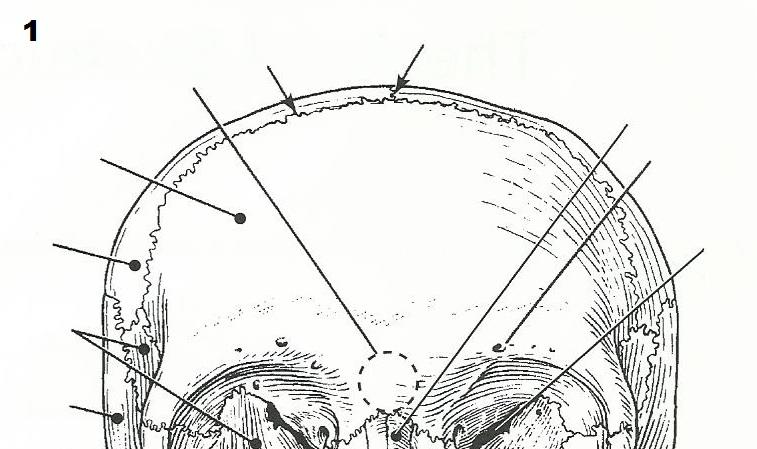
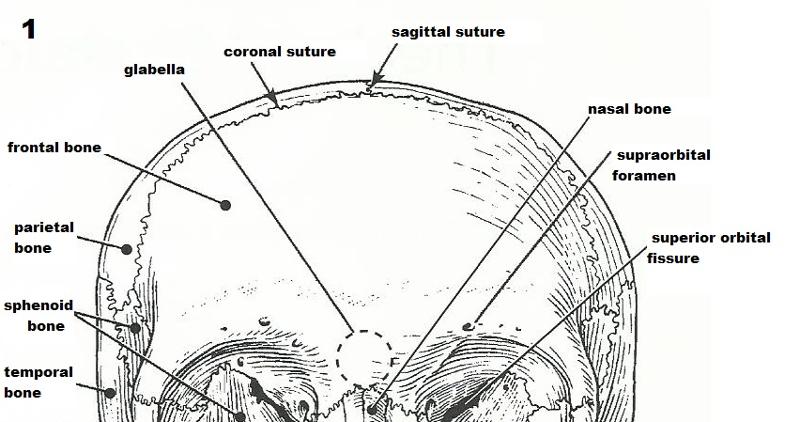

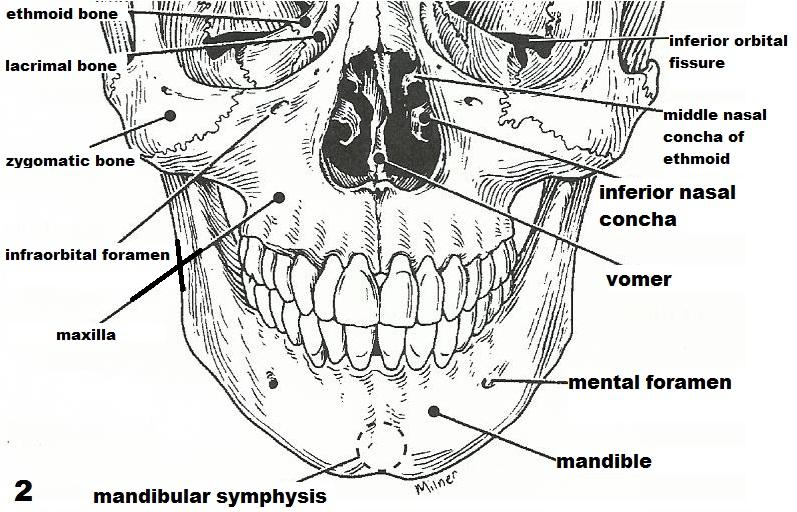
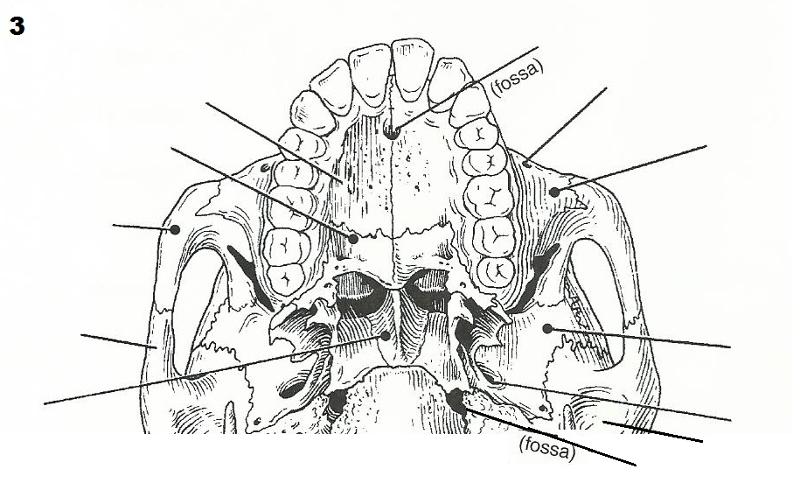
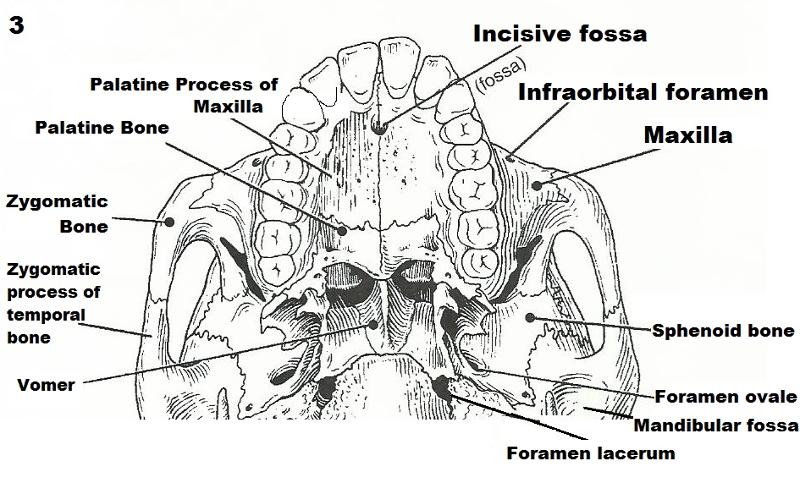
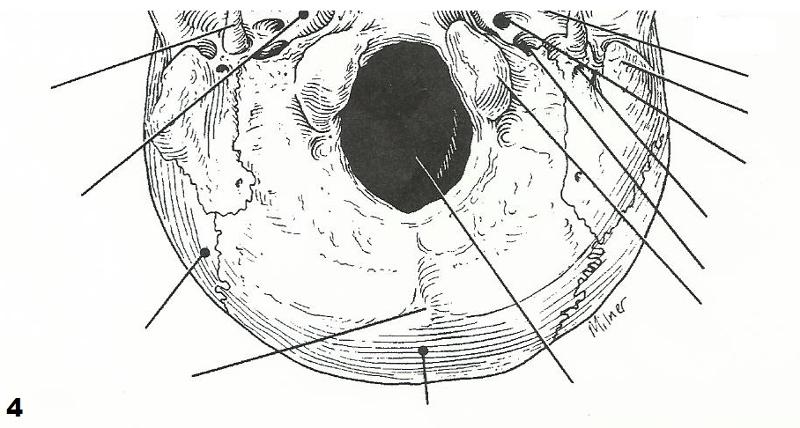
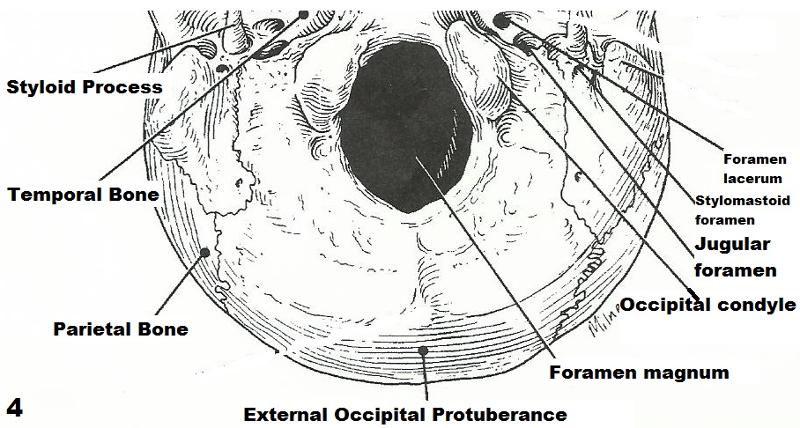
Define suture
All but one of the bones of the skull are joined by interlocking joints.
With one exception, the skull bones are joined by sutures. Name the exception.
With the exception of 2 paired bones (the parietal and temporal), are all single bones.
What bones are connected by the lambdoid suture?
connects the parietal and temporal bones with the occipital bone
What bones are connected by the squamous suture?
temporal and parietal bones on each side of the skull.
Name the eight bones composing the cranium.
frontal bone, 2 parietal bones, 2 temporal bones, occipital bone, sphenoid, ethmoid
Give two possible functions of the sinuses:
They lighten the facial bones and act as resonance chambers for speech.
What is the orbit?
Eye Socket
What bones contribute to the formation of the orbit?
Frontal bone, maxilla, lacrimal, ethnoid, sphenoid, palatine, zygomatic.
Why can the sphenoid bone be called the keystone of the cranial floor?
Since it is in contact with all of the other cranial bones.
cervical vertebra - typical
vertebral type containing foramina in the transverse processes, through which the vertebral arteries ascend to reach the brain
axis
dens here provides a pivot for rotation of the first cervical vertebra (C1)
thoracic vertebra
transverse processes faceted for articulation with ribs, spinous process pointing sharply downward
sacrum
composite bone, articulates with the hip bone laterally
lumbar vertebra
massive vertebrae, weight sustaining
coccyx
"tail bone:; vestigial fused vertebrae
atlas
supports the head; allows a rocking motion in the conjunction with the occipital condyles
vertebral foramen
cavity enclosing the spinal cord
body
weight bearing portion of the vertebra
spinous process & transverse process
provide levers against which muscles pull
body & transverse process
provides an articulation point for the ribs
intervertebral foramina
openings providing for exit of spinal nerves
body & vertebral arch
structures that form an enclosure for the spinal cord
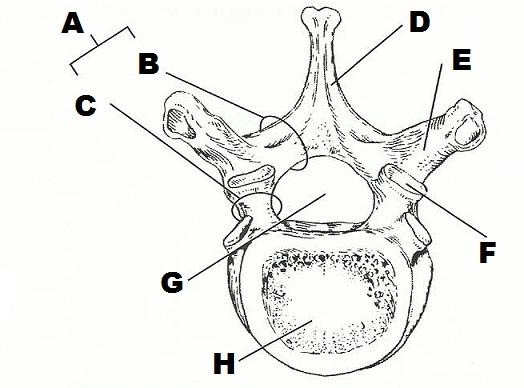
A. INTERVERTEBRAL FORAMINA
B. LAMINA
C. PEDICLE
D. SPINOUS PROCESS
E. TRANSVERSE PROCESS
F. SUPERIOR ARTICULAR FACET
G. VERTEBRAL FORAMEN
H. BODY
Describe how a spinal nerve exits from the vertebral column.
Spinal nerves ( motor axons) exit the vertebral column via the ventral root (where they synapse on motor neuron ganglia ) then the ventral horn. Sensory nerves enter the spinal cord via the dorsal horn, synapse on the dorsal ganglia and enter the spinal cord.
name two factors/structures that permit flexibility of the vertebral column
discs and the S-shaped of the vertebral column prevent shock to the head in walking and running and provide flexibility to the body trunk
What kind of tissue compose the intervertebral discs?
fibrocartilage
What is a herniated disc? What problems might it cause?
a disc in which the nucleus puposus herniates through the annulus;
the nucleus pulposus compresses on the spinal cord leading to pain/possible paralysis
Which two spinal curvatures are observed at birth?
The two primary curvatures that we're born with are the concave forward curvatures in the thoracic and sacral spines.
Under what conditions do the secondary curvatures develop?
The "secondary" curvatures, the compensatory curvatures, occur with normal development. (Normal development is the condition under which they occur) These are the cervical curvature, which develops first with infant head lifting and the lumbar curvature, which develops next sitting up. These curvatures prepare the spine for ambulation.
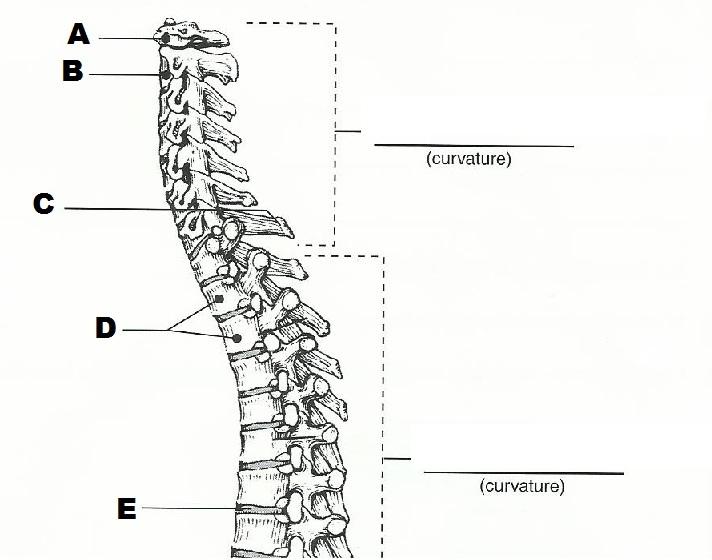
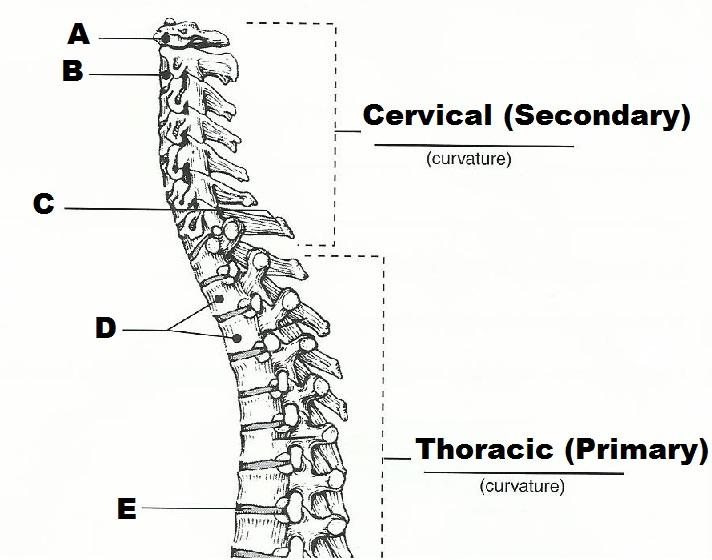
A. ATLAS
B. AXIS
C. VERTEBRA PROMINENS
D. TWO THORACIC VERTEBRAE
E. INTERVERTEBRAL DISC
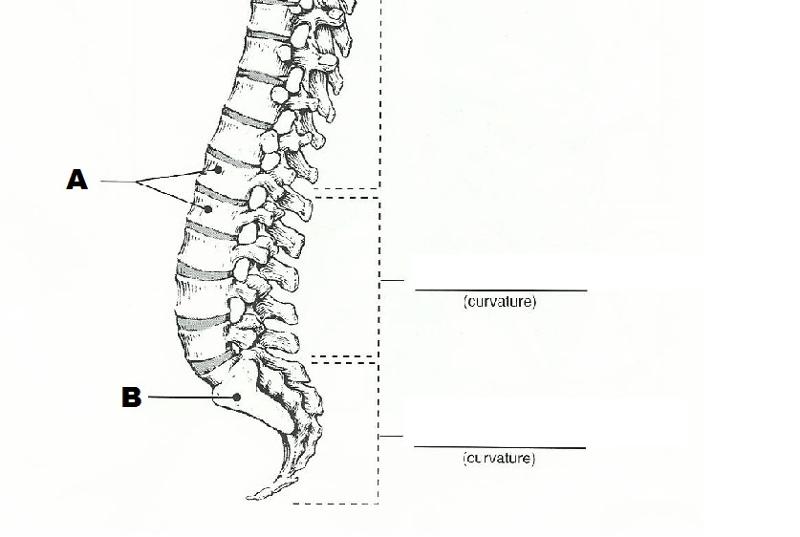
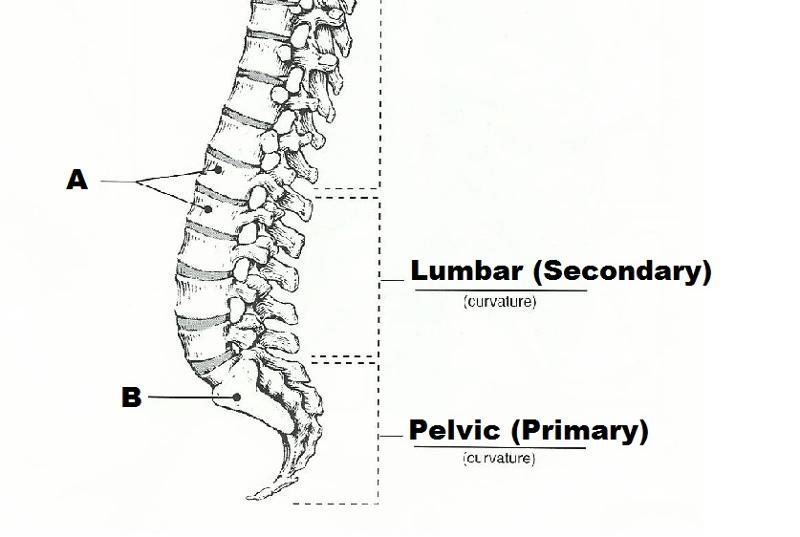
A. TWO LUMBAR VERTEBRAE
B. SACRUM
The major bony components of the thorax (excluding the vertebral column) are the ___________ and the _______________.
ribs and sternum
Differentiate between a true rib and a false rib.
a true rib is attached to cartilage that directly articulates with the sternum
Is a floating rib a true or false rib?
A free floating rib is neither a true or false rib. Ribs 1-7 are considered "true" ribs because they are directly attached to the sternum by individual coastal cartilages. Ribs 8-10 are considered "false" ribs because they are indirectly attached to the sternum by a common coastal cartilage. Ribs 11 and 12 are considered "free floating" because they are neither directly or indirectly attached to the sternum. Instead, they end in posterior abdominal musculature. They are still capped with cartilage though
What is the general shape of the thoracic cage?
cone-shaped
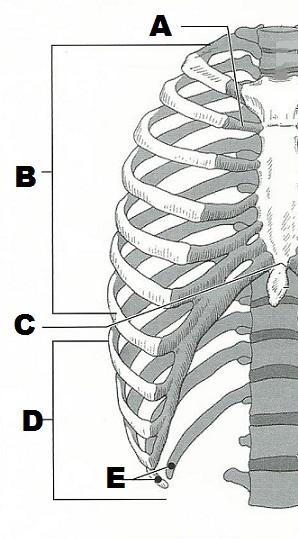
A. COSTAL CARTILAGE
B. TRUE RIBS
C. XIPHISTERNAL JOINT
D. FALSE RIBS
E. FLOATING RIBS
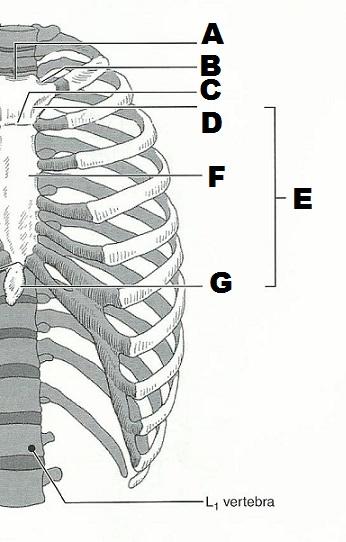
A. JUGULAR NOTCH
B. CLAVICULAR NOTCH
C. STERNAL ANGLE
D. MANUBRIUM
E. STERNUM
F. BODY
G. XIPHOID PROCESS